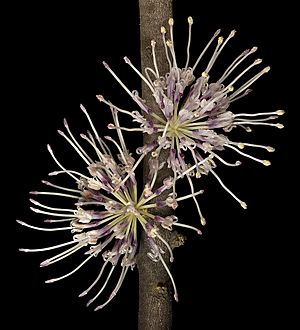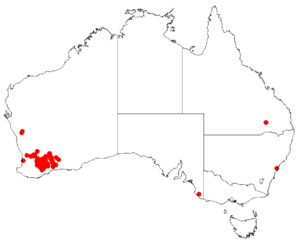Hakea subsulcata facts for kids
Quick facts for kids Hakea subsulcata |
|
|---|---|
 |
|
| Scientific classification | |
| Genus: |
Hakea
|
| Species: |
subsulcata
|
 |
|
| Occurrence data from Australasian Virtual Herbarium | |
Hakea subsulcata is a special kind of shrub that belongs to the Proteaceae plant family. It only grows in certain parts of Western Australia, especially in the Wheatbelt, Great Southern, and Goldfields-Esperance regions. This means it is an endemic plant, found nowhere else in the world!
Contents
What Hakea subsulcata Looks Like
This plant is usually a shrub that stands upright or spreads out. It can grow to be about 1 to 3 meters (3 to 10 feet) tall. Unlike some plants, it does not form a lignotuber, which is a woody swelling at the base that helps plants regrow after fire.
Branches and Leaves
When the plant is flowering, its smaller branches are covered with soft, flat hairs. The branches that hold the flowers are smooth. The leaves are a blue-grey color and are shaped like long, thin cylinders, which is called terete. They are about 3 to 13 centimeters (1 to 5 inches) long and less than 1 millimeter thick. Each leaf ends in a slightly blunt point. The leaves can be smooth or have a few flat, soft hairs. They also have 12 long lines, or veins, running along their length.
Flowers and Fruit
The flowers of Hakea subsulcata grow in a round cluster called an umbel, which looks like a small umbrella. Each cluster has about 50 large flowers that can be purplish, mauve, or creamy-white. These flower clusters usually grow on the bare wood of the plant, or sometimes below the leaves.
The small stalks that hold each flower are called pedicels and are purple and smooth. The flower parts that protect the reproductive organs are called the perianth and are mauve. The female part of the flower, called the pistil, is cream-colored and about 10 to 13.5 millimeters long.
After flowering, the plant produces small fruits. These fruits are narrow, about 1 to 2 centimeters (0.4 to 0.8 inches) long and less than 1 centimeter (0.4 inches) wide. They taper into a cone-shaped tip and often grow in a cluster. Hakea subsulcata usually flowers from May to September.
How Hakea subsulcata Got Its Name
The scientific name Hakea subsulcata was first officially described by a scientist named Carl Meisner in 1845. He published his description in a book called Plantae Preissianae.
The name subsulcata comes from two Latin words: sub, meaning "somewhat," and sulcatus, meaning "grooved." This name refers to the slightly grooved look of the plant's leaves.
Where Hakea subsulcata Lives
This plant grows in a wide area of Western Australia. You can find it from Wyalkatchem in the north, all the way south to Gnowangerup and Ravensthorpe.
It likes to grow in areas with heathland, scrub, and woodland. It prefers soil that drains water well, such as clay, different types of sand, and loam. Often, this soil is found over a type of rock called laterite and might have gravel in it. Sometimes, it even grows on ridges.
This plant is also considered an ornamental species, which means it's pretty enough to be grown in gardens. It can also be used to create hedges or low windbreaks.
Conservation Status
The Western Australian Government has looked at Hakea subsulcata and decided that it is "not threatened." This means that there are enough of these plants in the wild, and they are not currently at risk of disappearing.

